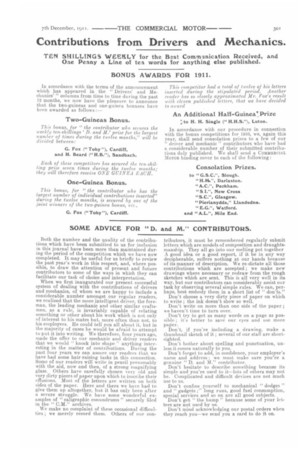SOME ADVICE FOR "D. and M." CONTRIBUTORS.
Page 19

If you've noticed an error in this article please click here to report it so we can fix it.
Both the number and the quality of the contributions which have been submitted to us for inclusion in this journal have been more than maintained during the period of the competition which we have now completed. It may be useful for us briefly to review the past year's work in this respect, and, where possible, to draw the attention of present and future contributors to some of the ways in which they can facilitate our task of choice and interpretation. When we first inaugurated our present successful system of dealing with the contributions of drivers and mechanics, of whom we are happy to include a considerable number amongst our regular readers, we realized that the more intelligent driver, the foreman, the leading mechanic and other similar craftsmen, as a rule, is invariably capable of relating something or other about his work which is not only of interest to his mates but, more often than not, to his employers. He could tell you all about it, but in the majority of cases he would be afraid to attempt to put it into writing. We therefore, four years ago, made the offer to our mechanic and driver readers that we would " knock into shape" anything interesting in the matter of contributions. During the past four years we can assure our readers that we have had some hair-raising tasks in this connection, Some of our readers will write in pencil presumably with the aid, now and then, of a strong magnifying glass. Others have carefully chosen very old and very dirty pieces of paper upon which to inscribe their effusions. Most of the letters are written on both sides of the paper. Here and there we have had to give them up altogether, but it has only been after a severe struggle. We have some wonderful examples of " caligraphic conundrums " securely filed in the " C.M." archives.
We make no complaint of these occasional difficulties; we merely record them, Others of our con
tributors, it must be remembered regularly submit letters which are models of composition and draughtsmanship. They all go into our melting pot together A good idea or a good report, if it be in any way decipherable, suffers nothing at our hands because of its manner of description. We re-dictate all those contributions which are accepted ; we make new drawings where necessary or redraw from the rough sketches which are sent. This is all very well in its way, but our contributors can considerably assist our task by observing several simple rules. We can, perhaps, best embody them in a short list of " don'ts." Don't choose a very dirty piece of paper on which to write ; the ink doesn't show so well.
Don't write on more than one side of the paper ; we haven't time to turn over.
Don't, try to get as many words on a page as possible; it's better to save our eyes and use more paper. Don't, if you're including a drawing, make a thumbnail sketch of it ; several of our staff are shortsighted. Don't bother about spelling and punctuation, unless it comes naturally to you. Don't forget to add, in confidence, your employer's name and address ; we must make sure you're a genuine " D. and M." contributor. Don't hesitate to describe something because its simple and you're used to it—lots of others may not be. Complicated and difficult devices are not much use to us.
Don't confine yourself to mechanical " dodges " and " gadgets ;" long runs, good fuel consumption, special services and so on are all good subjects. Don't get " the hump " because some of your letters are not used by us. Don't mind acknowledging our postal orders when they reach you—we send you a card to do it on.




















